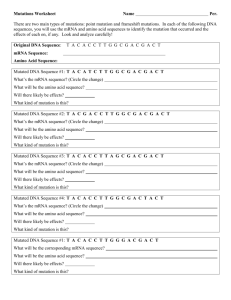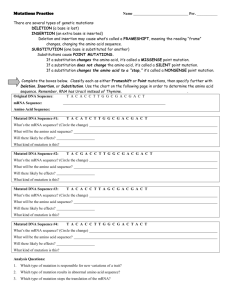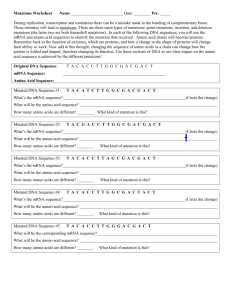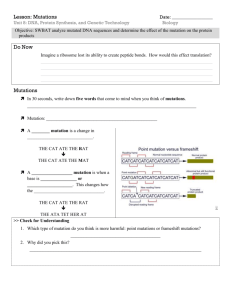Mutations Worksheet: DNA Sequence Analysis
advertisement
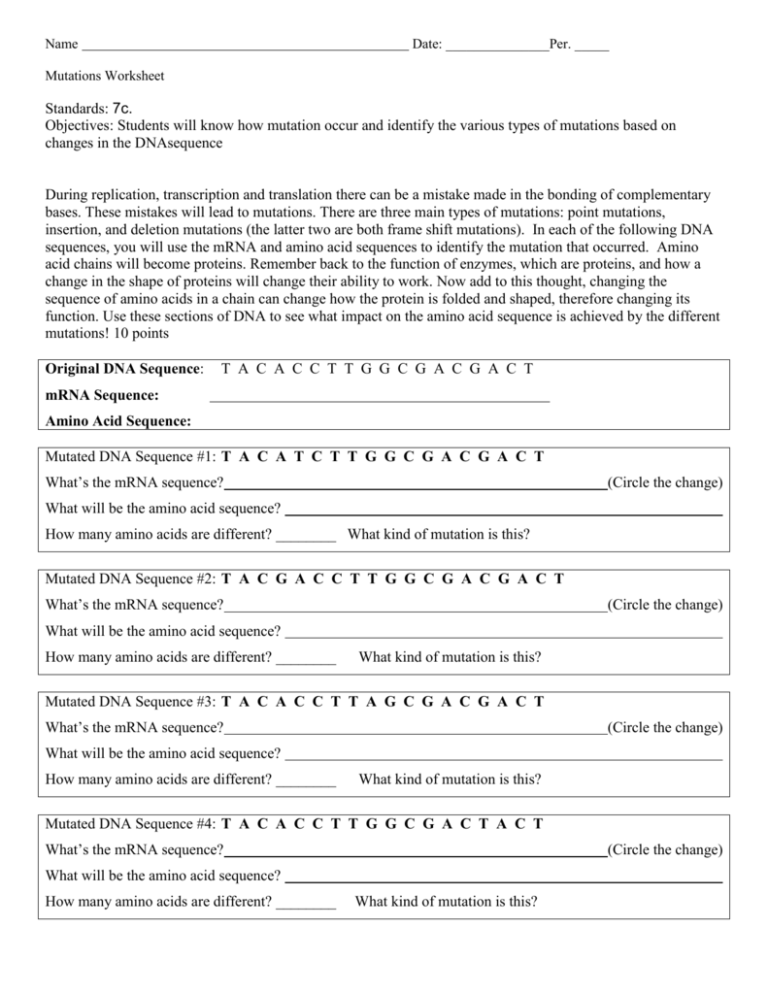
Name Date: _______________Per. _____ Mutations Worksheet Standards: 7c. Objectives: Students will know how mutation occur and identify the various types of mutations based on changes in the DNAsequence During replication, transcription and translation there can be a mistake made in the bonding of complementary bases. These mistakes will lead to mutations. There are three main types of mutations: point mutations, insertion, and deletion mutations (the latter two are both frame shift mutations). In each of the following DNA sequences, you will use the mRNA and amino acid sequences to identify the mutation that occurred. Amino acid chains will become proteins. Remember back to the function of enzymes, which are proteins, and how a change in the shape of proteins will change their ability to work. Now add to this thought, changing the sequence of amino acids in a chain can change how the protein is folded and shaped, therefore changing its function. Use these sections of DNA to see what impact on the amino acid sequence is achieved by the different mutations! 10 points Original DNA Sequence: T A C A C C T T G G C G A C G A C T mRNA Sequence: Amino Acid Sequence: Mutated DNA Sequence #1: T A C A T C T T G G C G A C G A C T What’s the mRNA sequence? (Circle the change) What will be the amino acid sequence? How many amino acids are different? ________ What kind of mutation is this? Mutated DNA Sequence #2: T A C G A C C T T G G C G A C G A C T What’s the mRNA sequence? (Circle the change) What will be the amino acid sequence? How many amino acids are different? ________ What kind of mutation is this? Mutated DNA Sequence #3: T A C A C C T T A G C G A C G A C T What’s the mRNA sequence? (Circle the change) What will be the amino acid sequence? How many amino acids are different? ________ What kind of mutation is this? Mutated DNA Sequence #4: T A C A C C T T G G C G A C T A C T What’s the mRNA sequence? (Circle the change) What will be the amino acid sequence? How many amino acids are different? ________ What kind of mutation is this? Mutated DNA Sequence #5: T A C A C C T T G G G A C G A C T What will be the corresponding mRNA sequence? What will be the amino acid sequence? How many amino acids are different? ________ What kind of mutation is this? Discussion Questions: (you may use your table partners) 1. If mutated DNA Sequence #1 occurred in a single cell on the membrane of a fish, how might it impact the organism? 2. If mutated DNA Sequence #1 occurred in a single reproductive cell of a fish that was later fertilized to become an offspring, how might it impact the organism? 3. If mutated DNA Sequence #2 occurred in a reproductive cell of a fish that was later fertilized to become an organism. And the mutation occurred in a gene that coded for a hormone needed for growth, how might it impact the organism? 4. If mutated DNA Sequence #1 occurred in a reproductive cell of a fish that was later fertilized to become an organism. And the mutation occurred in a gene that coded for a pigment that normally appears blue and as a result of the mutation appears red, how might it impact the organism? 5. DNA replication, transcription, and translation all have enzymes whose job it is to attach the complementary nucleotides to an existing strand. Nonetheless, these enzymes do make mistakes at a rate of about 1 per every 100,000 nucleotides. That might not seem like much, until you consider how much DNA a cell has. In humans, with our 6 billion base pairs in each diploid cell, that would amount to how many mistakes? 6. In order to reduce the number of mutations drastically organisms have enzymes that proofread new strands of DNA and RNA and fix mutations. Mutation rates vary depending on species from mutation rates as low as 1 mistake per 100 million to 1 billion nucleotides, mostly in bacteria, and as high as 1 mistake per 100 to 1,000 nucleotides, the latter in a group of error-prone polymerase genes in humans. Even low mutation rates can accumulate over time. What might be an positive effect of mutations (think about question 4)?
